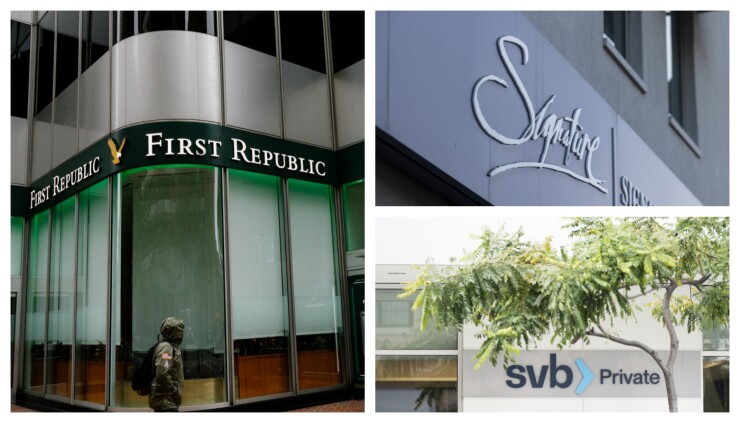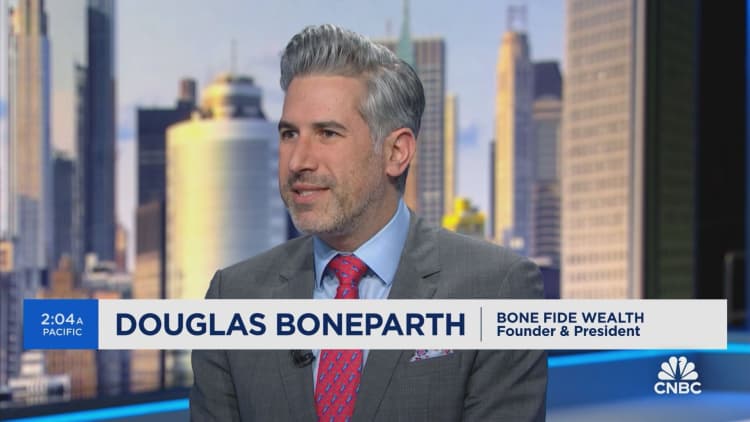The Government Accountability Business workplace positioned that Silicon Valley, Signature and First Republic banking establishments on the eve of their failures borrowed considerably extra from the House Personal loan Lender System than a workforce of their friends that built-in 16 skilled banking companies.
Silicon Valley Bank, Signature Bank and Initially Republic Bank larger their excellent borrowings from the Federal Dwelling Financial loan Lender Process by excess of a third each single shortly forward of failing, based on the Governing administration Accountability Business workplace.
The enhance in borrowings is the subject of a 27-webpage GAO report issued final week that examines the operate of the Federal House Personal loan monetary establishments in furnishing liquidity to their associates via the banking catastrophe within the spring of 2023. The report offers a granular purchase on the place {dollars} was going to the unsuccessful monetary establishments within the ninth inning of their existence as every sought to stem enormous outflows from depositors.
The GAO uncovered that the three banking establishments borrowed considerably extra from the Home Loan Financial establishment Process than a group of their friends that supplied 16 industrial banking companies.
The report is the to begin with in a assortment by which the GAO will look at broader challenges linked to the Dwelling Loan Bank System. The private neighborhood of 11 regional, cooperative banks was produced in 1932 instantly after the Wonderful Melancholy to function a provide of funding for thrifts originating house loans. The report was requested by Household Economic Companies Committee Chairman Patrick McHenry, R-N.C., and the panel’s rating Democrat, Rep. Maxine Waters of California.
“GAO uncovered the FHLBs of New York and San Francisco supplied main ranges of developments to those banks in comparison with different individuals, and that Signature Financial establishment made use of FHLB improvements to offset liquidity gaps it skilled linked to crypto-relevant deposits,” Waters acknowledged last 7 days in a press launch. “Meanwhile, SVB was not in a position to reposition collateral promptly sufficient from its FHLB to the Fed’s discounted window to entry disaster liquidity.”
Starting up on March 1, 2023, SVB improved its borrowings by 50% to $30 billion after which failed a 7 days afterwards. Signature’s borrowings rose 37% to $11.2 billion within the to begin with two weeks of March previous to it failed that similar month. And Initially Republic’s borrowings jumped 45% to $28.1 billion within the preliminary two weeks of March previous to it unsuccessful in May, the GAO report found.
The GAO regarded at the communication and coordination of the Home Financial loan monetary establishments with the Federal Deposit Insurance Corp. and Federal Reserve System — the unsuccessful banks’ main federal regulators — and the compensation of the failed banks’ distinctive monetary loans, recognised as advances, to the system.
“A single of crucial spots of focus is: Are the Federal Property Bank loan banking establishments dealing with their associations and their counterparty hazard with establishments as they begin off to are unsuccessful, and have they got the precise agreements and oversight in place with the Fed and others?” reported Jim Parrott, co-operator of Parrott Ryan Advisors and a nonresident fellow at the Urban Institute. “When every little thing’s possible 90 miles an hour, as an institution commences to only take on water, are all of the relevant regulators and different people who’re in some feeling not directly accountable for taxpayer challenges … coordinating?”
The GAO reported that SVB failed previous to the Federal Home Personal loan Financial establishment of San Francisco was succesful to request extra supervisory particulars from the Federal Reserve Lender of San Francisco. The New York and San Francisco Household Mortgage banking companies the 2 have been geared up to attach with the FDIC about Signature and Very first Republic as these banking establishments had been declining, the GAO reported.
“It was placing to me that [the Home Loan banks] stored lending to those failing banking establishments till the fairly previous 7 days or instances forward of they failed,” mentioned Sharon Cornelissen, director of housing at the Shopper Federation of The us and chair of the Coalition for FHLB Reform. “Only because the Federal Dwelling Bank loan Financial establishment of San Francisco doesn’t lend across the weekend, SVB was frantically in search of to achieve entry to the [Fed’s] worth discount window at the gorgeous earlier second.”
The report was produced fairly a few months instantly after the Federal Housing Finance Agency’s analysis of the method. FHFA, the system’s regulator, produced a 100-year evaluate of the House Financial loan banking establishments in November that included 50 suggestions for reforms. Waters mentioned she is doing work on legal guidelines to use a lot of of the FHFA’s suggestions, together with doubling the system’s contributions to cost-effective housing to twenty% from the most recent congressionally-mandated 10%. She is also discovering methods to extend entry and working of the Fed’s low value window.
Teresa Bazemore, president and CEO of the San Francisco Dwelling Financial loan Lender, mentioned in an job interview final week that it’s important to have an understanding of what was occurring upfront of the March 2023 liquidity catastrophe. Banking companies and credit score rating unions have been flush with document levels of deposits in 2021 from governing administration stimulus packages in response to the pandemic. At that point, the Residence Mortgage banks’ core small enterprise of supplying liquidity to members skilled dried up. But in 2022, income trade mutual money commenced offering depositors increased expenses, inserting heaps of banking establishments in a squeeze.
“Some of the revenue began to outflow from [member] banking establishments at the similar time people establishments had by now invested some of that money. They’d now loaned it out, they’d presently created house finance loan loans [and] put them of their portfolios. They purchased securities,” Bazemore mentioned. “So when you look at wherever objects had been at the conclusion of 2021 to the shut of 2022, you noticed our developments go up as a method just because of that switch of deposits out of the banking establishments and credit standing unions. And that’s genuinely what the method was established up for.”
The Federal Reserve hiked need charges 11 events involving 2022 and 2023 in an attempt to management inflation. As a outcome, fairly a few banking establishments ended up “the other way up” and desired to borrow from the Dwelling Personal loan Financial establishment System, or alternatively, needed to carry in brokered deposits, Bazemore talked about. Brokered deposits are usually designed by corporations with the assistance of a third bash.
“If you have got acquired a portfolio of 3% mortgage loan monetary loans, the place by are you heading to get the money circulate to spend 4% or 5%, to compete with the money market [funds]?” Bazemore requested.
The GAO report additionally appeared at the reimbursement of improvements by the failed banks and whether or not or not there was a worth to the federal Deposit Insurance plan Fund. Right after regulators took intense strategies last calendar yr to protect uninsured depositors, notably enterprise capitalists quickly after the failure of SVB, the FDIC assessed a distinctive price on extra than 100 banks to replenish the fund, acknowledged in lender parlance because the “DIF.”
The GAO report talked about that reimbursement “doesn’t impose a quick value” however that “exploration conclusions fluctuate” in regards to the threats that unsuccessful banks’ improvements from this system pose to the DIF. Dwelling Mortgage banking establishments have a priority placement ahead of the FDIC when a lender goes into receivership, an issue that has transform a bone of competitors among the many critics of this system.
The GAO claimed that in 2000 and 2005, respectively, analysis by the Fed and FDIC famous that “FHLBanks’ precedence place in receivership may subsidize member bank danger-getting, which may point out greater losses for the Deposit Insurance coverage Fund.”
The GAO additionally reported that a 2023 FHFA consider of tutorial literature recognized that House Loan banks’ regulatory pointers and practices mitigate moral-hazard issues, while a analysis by the City Institute previous calendar yr recognized that an improve in a industrial bank’s use of improvements lowers the percentages of failure, considerably for a scaled-down bank.
However, the report identified that “if proceeds of the failed bank’s liquidated property don’t defend guarantees eligible for the fund instantly after compensation of FHLBank advances and some other secured statements, the Deposit Insurance plan Fund would incur bills.”
The GAO report additionally detailed the bills billed by each of these the San Francisco and New York Property Mortgage banking establishments, which numerous significantly.
Bank failures might presumably trigger prepayment service charges that the Dwelling Loan monetary establishments value, that are crucial by the FHFA for explicit options. Waiver prices additionally might maybe be billed if a member-financial establishment will make voluntary prepayments. The Home Bank loan banking establishments additionally might waive the costs, and even cost the FDIC, because the receiver of a unsuccessful lender, a waiver fee to compensate for pitfalls.
Prepayment penalties additionally fluctuate dependent on the size and phrases of an advance. The FDIC ordinarily pays off enhancements and incurs a price in get to only take the collateral that has been pledged by a industrial monetary establishment to a Household Bank loan bank.
After SVB failed, the FDIC transferred all its deposits and roughly all of its property to Silicon Valley Bridge Financial establishment, which repaid the $30 billion in excellent developments to the San Francisco Dwelling Bank loan Lender. The San Francisco bank acquired $266.5 million in prepayment bills and $18.8 million in waiver service charges. Most of SVB’s developments skilled phrases of a particular person to 3 a few years.
“SVB didn’t have a sure talked about tactic for borrowing developments in that maturity fluctuate,” the GAO talked about, citing officers from the San Francisco Property Mortgage Financial establishment.
Meanwhile Very first Republic’s wonderful developments have been assumed by JPMorgan Chase, which repaid roughly $5.8 billion in monetary loans that had attained maturity, and has indicated that it plans to repay the remaining developments based on the progress circumstances.
In distinction, after Signature Financial establishment unsuccessful, the Federal Property Financial loan Bank of New York additionally been given complete compensation for Signature’s $11.2 billion in unbelievable developments however acquired simply $260,000 in prepayment prices and no waiver expenses.
“The broader dialogue is irrespective of whether or not that is the half that we would like [the FHLBs] to carry out,” Cornelissen claimed. “According to the regulation they ended up inside simply their rights to provide liquidity, however we should always actually be a lot extra tightly regulating them primarily as a result of it actually shouldn’t be their put to be the loan supplier of earlier resort. They are going to protect lending till finally the gorgeous earlier working day primarily as a result of that’s their firm design and provides no hazard to them.”
Ryan Donovan, president and CEO of the Council of Federal Home Bank loan Financial establishments, the system’s commerce group, applauded the GAO report for locating that the method designed makes an attempt to coordinate with the Federal Reserve monetary establishments of New York and San Francisco in accordance with insurance coverage insurance policies and processes.
“We benefit from the conclusions within the GAO’s report, and we predict they validate what we have now been indicating for a yr: that the FHLBanks acted as a essential shock absorber for the fiscal system all through a time interval of unparalleled turbulence within the spring of 2023,” Donovan talked about. “The two most important takeaways from this report are that the FHLBanks provided essential liquidity to their members in direct accordance with the framework and performance laid out for them by Congress, and that the FHLBanks labored tirelessly in a coordinated vogue with main monetary regulators to make sure the security and soundness of the U.S. banking process.”
The Federal Home Personal loan Bank Technique famous earnings of $6.7 billion at yr-stop, an 111% soar from a yr earlier than. The course of additionally paid out a historical past $3.4 billion in dividends to its associates, extra than double the $1.4 billion compensated in 2022.
The GAO report is dated March 8 however was unveiled on April 8 following lawmakers and the Residence Mortgage banking companies had a month to guage its conclusions.



